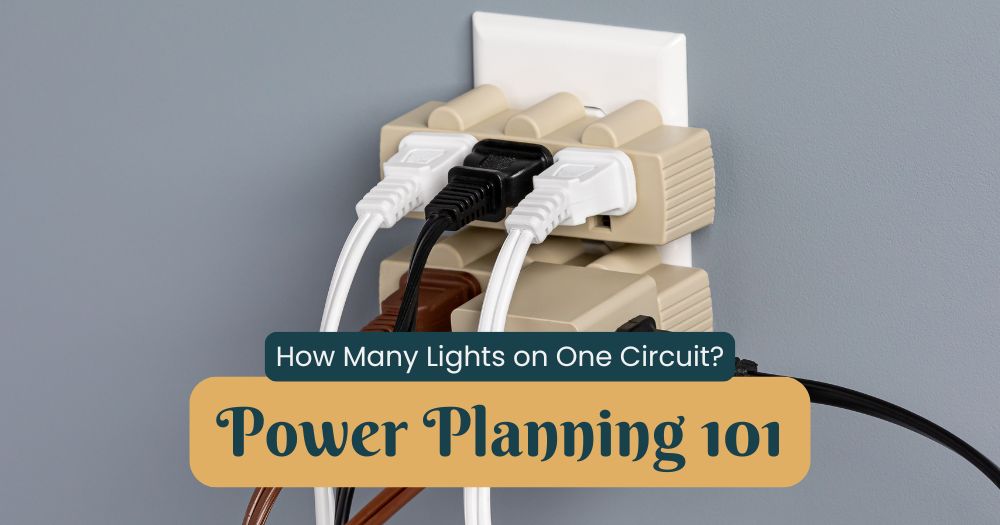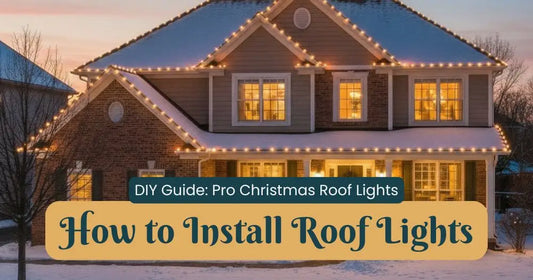How Many Christmas Lights Can I Run on One Circuit?

If you’ve ever asked “how many Christmas lights can I run on one circuit?” this Christmas light power planning guide is for you. With a few quick formulas and smart accessories, you’ll design a brighter, safer display, avoid mid-season GFCI trips, and keep installation tidy enough to make Santa jealous.
The holiday season is the busiest time for planning and installing Christmas lights, making safe and effective power planning especially important during this festive period.
The quick answer (and why it matters)
Here’s the fast math most decorators use. Standard household voltage is about 120V. A typical 15A circuit (the most common household circuit is rated at 15 amps) should be treated as 80% max for continuous loads (anything on for 3+ hours), and the same idea applies to 20A circuits unless the breaker is marked for 100% continuous duty. That means target loads of about 12A on a 15A circuit and 16A on a 20A circuit. A circuit can be safely loaded to a maximum of 1440 watts on a 15-amp circuit. The 80% guidance comes from electrical product/application rules for breakers; unless a breaker is specifically rated for 100% continuous operation, assume 80% as your safe ceiling. Source: UL guidance on continuous loading of circuit breakers. Underwriter's Laboratory (UL) is the recognized authority for safe circuit loading and maximum wattage recommendations. As a rule of thumb, the 80% rule helps prevent overloading a single circuit by keeping the load well below the maximum wattage.
Example capacity at 120V (using the 80% rule and formula for safe load calculation):
- 15A circuit safe target: 12A x 120V ≈ 1,440 watts (to determine how many watts your single circuit can handle, multiply amps by volts)
- 20A circuit safe target: 16A x 120V ≈ 1,920 watts
- A typical 15-amp circuit can handle up to 1800 watts based on the standard voltage of 120 volts.
To figure out how many strings of lights you can safely connect, divide the maximum wattage by the wattage of each string.
PRO TIP: You also have to consider the load rating for the wire gauge of the light strings you are using. lighter weight (higher gauge) wire will experience greater voltage drop over distance, so if you are looking at very long runs of lights, you will need to research the affect of voltage drop over distance as and include that as a variable in your calculations.
What does that mean in lights?
- Modern LED minis often draw roughly 3–6 watts per set and C7/C9 LED bulbs typically use under 1 watt each, so you can run a lot of LED before hitting those limits. LEDs also save significant energy versus incandescents. Energy.gov notes LEDs use about 80-90% less energy than traditional strands. (For example, to calculate how many strings of LED lights you can safely run, divide your circuit's maximum wattage by the wattage per string.)
- Incandescent strings draw much more. With old-school minis, you can hit your wattage ceiling fast, and many authorities still advise no more than three incandescent strings end‑to‑end for safety. Incandescent Christmas lights can consume up to 10 times more power than LED lights. See ESFI’s holiday safety tips.
Note: Always determine your total load and never exceed the safe maximum wattage for your circuit.
Warning: Overloading a circuit can cause overheating and increase the risk of fire. Always follow UL and local electrical safety guidelines.
Step 1: Do the simple circuit math
Use these two formulas for Christmas light power planning:
- Watts = Volts × Amps
- Amps = Watts ÷ Volts
When calculating your circuit load, add up the total wattage of all connected devices, including Christmas lights and any other appliances. To calculate the amperage, divide the total wattage by the household outlet voltage (typically 120V). Calculating this way helps ensure you do not exceed safe limits for your wiring and outlets. Keep the total under 80% of the breaker rating. Unless your breaker and enclosure are explicitly marked for 100% continuous load, treat your Christmas display as continuous and stick to that 80% ceiling. Reference: UL breaker application guidance.
PRO TIP: A single receptacle may share a circuit with other outlets and indoor loads. If a vacuum or space heater trips your lights, that circuit is already busy with other devices and appliances. Be sure you account for ALL receptacles on the same circuit when calculating how many lights you can plug into any given receptacle.
Step 2: Estimate real-world load for LEDs vs. incandescents
- LED example: Ten strings at 5 watts each = 50 watts. 50 ÷ 120 ≈ 0.42 amps. Plenty of headroom remains. LED Christmas lights are especially efficient, allowing you to connect more strings together safely due to their low power consumption and reduced heat output.
- C9 LED example: 100 bulbs at 0.8 watts each = 80 watts total. 80 ÷ 120 ≈ 0.67 amps.
- Incandescent example: Ten strings of mini lights at 40 watts each = 400 watts. 400 ÷ 120 ≈ 3.33 amps. Mini lights typically have higher wattage than LEDs, so you’ll approach limits quickly as you scale.
Want bright, efficient rooflines with classic shape? Choose LED C7/C9 - Explore vivid, dimmable options in our C9 LED bulbs collection.
Step 3: Plan your branch runs and reduce voltage drop
Long cord runs can increase resistance and voltage drop, which can dim bulbs or cause nuisance trips in wet weather. Break your design into shorter, cleaner branches that feed from multiple outlets. For large or complex displays, consider running separate electrical circuits dedicated to your Christmas lights to prevent overloading and allow for safer, more flexible outlet placement. Avoid connecting too many lights to the same circuit, as this can increase the risk of overload and potential safety hazards. Check each lightbulb and cord for nicks or abrasions to ensure safety. Where you need custom lengths (to eliminate cord spaghetti), build professional, exact‑fit jumpers using SPT wire and slide‑on plugs.
- Learn the difference between SPT‑1 vs. SPT‑2 insulation and match your plugs to the wire type.
- Create tidy, custom leads and in‑line tap points with our Slide‑On Vampire Plugs collection. Inline female pass‑throughs let you drop power exactly where you need it on a run.
Step 4: Keep moisture out and GFCIs happy
Outdoor displays should be plugged into GFCI‑protected receptacles and use lighting rated for outdoor use. That’s not just best practice—it’s safety 101 from consumer safety agencies. CPSC guidance recommends GFCI protection and outdoor‑rated sets for exterior displays. Overloaded or wet connections can increase fire danger, so always ensure your setup is within circuit capacity and protected from moisture.
Moisture is the #1 Grinch. A little water in a plug can trip GFCIs repeatedly, and moisture can also cause a short circuit, leading to tripped breakers or other hazards. Do this:
- Elevate connections and form drip loops.
- Use covers and gaskets at plug junctions. Our Weatherproof Plug Gaskets & Covers help keep water out so the show stays on.
- Keep unused C7/C9 sockets sealed to block water ingress. See socket covers.
PRO TIP: Do not wrap connections with electrical tape! This is a common error. If you wrap the connection, condensation will develop inside the wrapped connection and have no way to escape. You will end up having to unwrap the connection and let them dry out.
Step 5: Choose the right cords and clips
- Extension cords: Use cords rated for outdoor use and appropriate gauge for the load and length. Protect cords from pinch points and never bury connections. ESFI recommends checking for certification labels (UL/ETL/CSA) and avoiding overloads. Always check the tag on your lights to confirm if they are rated for indoor, outdoor, or both environments. Read ESFI’s safety checklist.
- Light clips: Skip nails and staples. Purpose‑built clips are faster, cleaner, and protect your wiring. Shop our Christmas Light Clips to match gutters, shingles, ridge lines, and wireframes. Before installation, check the box for manufacturer safety information and the maximum number of light sets that can be safely connected.
Step 6: Automate the on/off schedule
Automation saves energy and ensures lights aren’t left on overnight. Pair a photocell with a shut‑off timer or use a programmable outdoor timer or smart plug. Energy.gov recommends timers and photosensors to prevent lights from operating when not needed. See DOE’s lighting controls overview. Browse our Timers & Triple Taps to set‑and‑forget your display.
Handy reference table: safe circuit targets and examples
|
Circuit |
Safe continuous target (80%) |
Approx. LED minis (5W set) |
Approx. C9 LEDs (0.8W bulb) |
|---|---|---|---|
|
15A @ 120V |
~1,440 watts |
~288 sets |
~1,800 bulbs |
|
20A @ 120V |
~1,920 watts |
~384 sets |
~2,400 bulbs |
This table shows the total number of light sets or bulbs you can safely use on a given circuit.
To determine how many lights can I string together, use the table to find the maximum number of sets or bulbs that can be safely connected to your circuit. Make sure not to exceed the safe number of lights connected, as this can create electrical hazards.
Notes: These are theoretical maximums. Real designs should be split across multiple outlets, consider cord lengths/voltage drop, and include margin for wet weather and other household loads. Always remember to account for other lights or appliances already on the circuit when calculating your total load. We always recommend keeping your actual total amperage load at 80% of less of the maximum for your circuit.
Avoid these common mistakes
- Daisy‑chaining long extension cords to gain distance. Instead, make custom SPT jumpers or start a new branch from a nearer outlet.
- Mixing incandescent and LED on the same run. Incandescent inrush and higher wattage can cause nuisance trips; keep runs consistent.
- Ignoring shared circuits. A garage or exterior outlet often shares a breaker with interior lights or equipment.
- Exceeding manufacturer limits. Some products specify maximum end‑to‑end connections—follow them.
- Skipping GFCI protection or using indoor‑only cords outside. Both are big no‑nos. CPSC and ESFI emphasize GFCI use and proper ratings.
- Plugging too many lights or devices into a single outlet or power strip can cause overheating and increase the risk of fire.
- Overloading a power strip with Christmas lights may exceed its rated capacity, leading to potential electrical hazards.
Warning: Always follow safety guidelines when plugging in Christmas lights and using power strips to prevent electrical hazards and ensure safe operation.
Sample power plan you can copy
Let’s say you want: a C9 LED roofline, two net lights per shrub (six shrubs), and a small tree wrap.
- List loads
- Roofline: 100 C9 LEDs at 0.8W = 80W
- Nets: 6 nets at 15W = 90W
- Tree wrap: 8 LED mini sets at 5W = 40W
Total ≈ 210W → 210 ÷ 120 ≈ 1.75A
- Assign outlets and branches
- Branch A (right roofline + 3 nets): ~125W
- Branch B (left roofline + 3 nets + tree): ~85W
- Build clean connections
- Make two custom 18AWG SPT‑1 jumpers to reach roof corners with no slack, and add one inline female tap for the tree wrap using Slide‑On Vampire Plugs.
- You can string together multiple light sets end-to-end, but always check the box or manufacturer’s instructions for the maximum number allowed.
- Use gutter/shingle clips from our Clips collection to keep lines straight.
- Weatherproof and automate
- Cap any unused C9 sockets and gasket every plug junction.
- Use an outdoor photocell timer from our Timers collection set dusk–11pm. DOE notes timers and photosensors help cut wasted runtime.
- Final check
- Circuit headroom: 1.75A on a 15A circuit = plenty of margin.
- Before powering up, make sure you safely string the lights by following all manufacturer and UL safety guidelines to avoid overloading.
- Night test: Turn everything on, walk the line, and confirm no dim zones or sagging cords.
FAQs
-
How many LED strings can I connect?
Check each product’s “max end‑to‑end” spec first. From a circuit perspective, sum watts and stay under 80% of the breaker rating for continuous loads. UL’s breaker guidance explains the 80% assumption. -
Why are LED lights so much easier on power?
LEDs convert electricity to light far more efficiently than incandescent filaments and typically use 70–80% less energy. Energy.gov overview. -
Do I really need a GFCI outside?
Yes—exterior lighting should be on GFCI‑protected circuits and use outdoor‑rated equipment. CPSC holiday safety. -
What else can reduce nuisance trips?
Keep connections elevated and covered, avoid overlong runs, seal empty sockets, and avoid mixing incandescent with LED on the same branch. - Note: For complex or large-scale holiday lighting installations, or if you are unsure about your home’s electrical system, contact a licensed electrician or professional electrical service. They can ensure your setup is safe, meets code requirements, and help with surge protection and circuit management.
Ready to power up—safely and beautifully?
If you’d like help turning this plan into parts, our elves are here for you. Start with Slide‑On Vampire Plugs to custom‑fit your cords, add an outdoor Timer or Photocell, and button up every junction with Weatherproof Plug Gaskets & Covers. Then pick your perfect C9 LED bulbs and let the glow begin!
About The Christmas Light Emporium
At The Christmas Light Emporium, we're passionate about helping DIY decorators create safe, stunning holiday displays that bring joy to families and communities. We're the go-to source for professional-grade Christmas lights, decorations, and installation accessories—all backed by our industry-leading Reindeer Proof™ Warranty.
What makes us different? We focus exclusively on the DIY enthusiast. That means every product in our catalog is chosen for durability, safety, and ease of installation. From our exclusive ProCore LED bulbs that deliver brilliant color and energy efficiency, to our comprehensive collection of weatherproof connectors and precision light clips, we provide everything you need to execute your lighting vision safely and professionally.
Our expertise runs deep. Whether you're calculating circuit loads, planning complex roofline displays, or troubleshooting GFCI trips, our team understands the technical side of holiday lighting. We've helped thousands of decorators navigate power planning, voltage drop, weather protection, and a myriad of other amazing challenges—because the best displays combine creativity with solid electrical knowledge.
Why trust us? With 70,000+ happy customers and a 4.9-star rating, we've earned our reputation through quality products, expert guidance, and genuine care for your success. Our DIY guides, how-to articles, and responsive customer support ensure you're never decorating alone.
Ready to power up your next display safely and beautifully? Browse our collections of LED bulbs, professional accessories, and weatherproofing solutions. Join our community of Memory Makers—one brilliant bulb at a time.
Contact us: 1-888-444-XMAS (9627) | support@thechristmaslightemporium.com
🎄 Happy Decorating!



